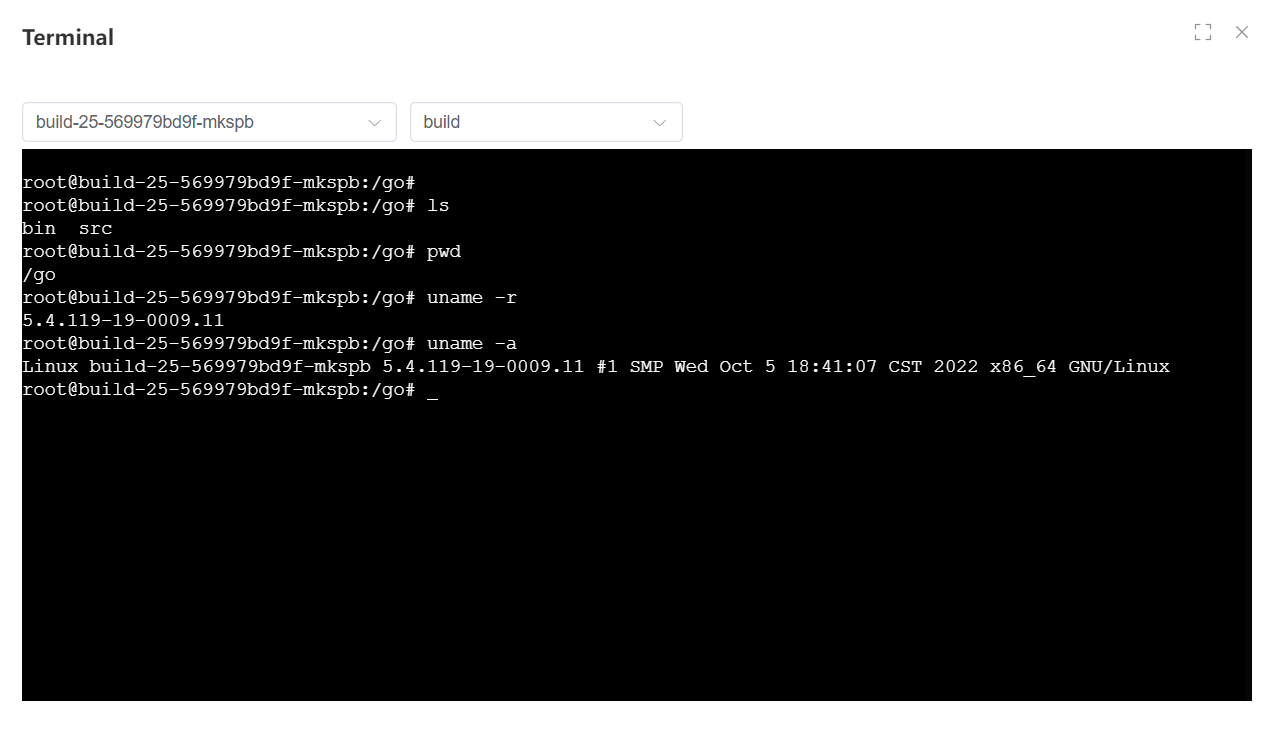python k8s web terminal
通过 python sanic 框架与 python kubernetes-client 实现 k8s 的 web terminal 功能
后端 Python [sanic]
python
@auth_only
async def webssh_pod(request, ws, cloud, env, namespace, podname, container):
if container == 'default':
container = None
stream = K8S(cloud, env).ssh(namespace, podname, container)
async def read_ws_to_stdin():
async for data in ws:
stream.write_stdin(data)
async def write_stdout_to_ws():
while stream.is_open():
stream.update()
while stream.peek_stdout():
await ws.send(stream.read_stdout())
while stream.peek_stderr():
await ws.send(stream.read_stderr())
await asyncio.sleep(0.01) # 极短等待,避免 100% CPU
try:
await asyncio.gather(
read_ws_to_stdin(),
write_stdout_to_ws()
)
except asyncio.CancelledError:
print("User closed connection")
finally:
stream.close()python
from kubernetes.stream import stream
class K8S():
# ...
def ssh(self, namespace, podname, container=None):
"""登录 pod 终端
https://github.com/kubernetes-client/python-base/blob/master/stream/ws_client.py
"""
command = [
'/bin/sh',
'-c',
'TERM=xterm-256color; export TERM; [ -x /bin/bash ] '
'&& ([ -x /usr/bin/script ] '
'&& /usr/bin/script -q -c "/bin/bash" /dev/null '
'|| exec /bin/bash) '
'|| exec /bin/sh',
]
print(command)
return stream(
self.core_api.connect_get_namespaced_pod_exec,
podname, namespace,
command=command, container=container,
stderr=True, stdin=True,
stdout=True, tty=True,
_preload_content=False
)python
web.add_websocket_route(
webssh_pod,
'/webssh/pod/<cloud>/<env>/<namespace>/<podname>/<container>'
)- python web 端使用
websocket对接 k8s 的 stream 方法 - 并行处理输入输出(异步/事件驱动),用两个任务:一个专门读取 websocket 输入到 Pod,另一个专门从 Pod stdout/stderr 写回 websocket
- 如果你并不是使用的
sanic框架,也可以考虑使用 python websockets 库,sanic 的 websocket 实现用的就是此库
前端 Vue3 [xterm.js]
vue
<template>
<!-- <el-drawer v-model="show" :extraData="extraData"> -->
<sc-dialog v-model="show" :extraData="extraData" :close-on-click-modal="false" :close-on-press-escape="false" draggable destroy-on-close>
<el-select v-model="podname" style="width: 300px; margin-right: 10px; margin-bottom: 5px;" @change="changeTerminal">
<el-option v-for="item in pods" :key="item" :label="item" :value="item" />
</el-select>
<el-select v-model="container" style="margin-bottom: 5px;" @change="changeTerminal">
<el-option v-for="item in podContainers[podname]" :key="item" :label="item" :value="item" />
</el-select>
<div tabindex="-1" id="terminal"></div>
</sc-dialog>
</template>
<script>
import config from "@/config"
import 'xterm/css/xterm.css'
import { Terminal } from 'xterm'
import { WebLinksAddon } from '@xterm/addon-web-links'
import { FitAddon } from '@xterm/addon-fit'
import { AttachAddon } from '@xterm/addon-attach'
export default {
props: {
modelValue: { type: Boolean, default: false },
extraData: {type: Object, default: () => {} },
},
data() {
return {
show: false,
socket: null,
term: null,
podname: null,
container: 'default',
pods: [],
podContainers: {},
}
},
watch:{
modelValue(){
this.show = this.modelValue
},
async show(val){
this.$emit("update:modelValue", val)
if (this.show === true) {
await this.$nextTick()
this.openTerminal()
} else {
if (this.socket) this.socket.close()
if (this.term) this.term.dispose()
}
},
extraData() {
this.podname = this.extraData.podname
this.pods = Object.keys(this.extraData.pods)
this.podContainers = this.extraData.pods
this.container = this.extraData.pods[this.pods[0]][0]
},
},
mounted() {
this.show = this.modelValue
},
created() {
},
methods: {
openTerminal() {
const term = new Terminal()
// https://xtermjs.org/docs/api/terminal/interfaces/iterminaloptions/#optional-cursorstyle
term.options = {
cursorStyle: 'underline',
cursorBlink: true,
}
const socket = new WebSocket(`${config.WS_URL}/webssh/pod/${this.extraData.cloud}/${this.extraData.env}/${this.extraData.namespace}/${this.podname}/${this.container}`)
const attachAddon = new AttachAddon(socket)
const fitAddon = new FitAddon()
const linkAddon = new WebLinksAddon()
term.loadAddon(attachAddon)
term.loadAddon(fitAddon)
term.loadAddon(linkAddon)
term.open(document.getElementById('terminal'))
fitAddon.fit()
socket.onopen = () => { socket.send('\n') } // 当连接建立时向终端发送一个换行符,不这么做的话最初终端是没有内容的,输入换行符可让终端显示当前用户的工作路径
term.focus() // 貌似没有起作用
window.onresize = function() { // 窗口尺寸变化时,终端尺寸自适应
fitAddon.fit()
}
this.term = term
this.socket = socket
},
changeTerminal() {
if (this.socket) this.socket.close()
if (this.term) this.term.dispose()
this.openTerminal()
},
}
}
</script>
<style scoped>
</style>- 前端直接使用的是 xterm.js 库,它提供了一键对接
WebSocket stream的插件 attach;使用起来非常简单方便,不需要在前端写websocket相关方法 - 上面的代码是我将
web terminal功能单独为一个弹出框组件了,所以看起来代码很多。真正与xterm.js和websocket的代码就几行
效果图

- 可选择 pod 和相应的容器
